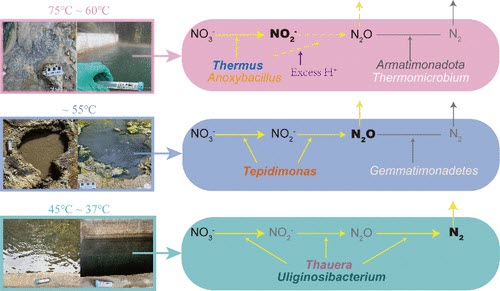Incomplete denitrification generates diverse nitrogen intermediates (e.g., NO2–, N2O), which may reshape nitrogen redox dynamics and modulate ecosystem functions. While prevalent in high-temperature ecosystems, the mechanisms regulating temperature-dependent denitrification remain unclear. To address this gap, we used hot springs with different temperatures (ranging from 37 to 75 °C) as representative environments and conducted enrichment cultures with both in situ hot spring water and defined media with varying acetate/NO3– ratios. Denitrification product profiles shifted systematically with temperature: NO2– dominated above 60 °C, NO2– and N2O at 55 °C, and N2 below 45 °C. Multiomics analyses revealed temperature-driven succession of dominant denitrifiers, with microorganisms affiliated with Thermus (>60 °C), Tepidimonas (55 °C), and Thauera/Uliginosibacterium (<45 °C). Denitrification core and accessory gene expressions showed temperature-specific patterns associated with intermediate formation. High expression of upstream core genes (e.g., narG) and limited expression of accessory genes in Thermus spp. promote incomplete denitrification at high temperatures, while low-temperature communities upregulated complementary pathways (e.g., nosRD with nosZ in Thauera spp.) for complete denitrification. Division of metabolic labor appears to be more important in denitrifying communities at high temperatures, where dominant denitrifiers perform incomplete denitrification and downstream intermediates are reduced by minor species (e.g., N2O reduction). These findings improve understanding of denitrification in thermally dynamic environments and reveal mechanisms underlying its temperature-dependent regulation.

Article link: https://pubs.acs.org/doi/10.1021/acs.est.5c00174





 Address
Address
 E-Mail
E-Mail
 Telephone
Telephone